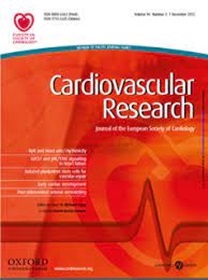An activator of PI3Kα restores cardioprotection from ischaemia/reperfusion injury in mice with coronary atherosclerosis or insulin resistance
IF 13.3
1区 医学
Q1 CARDIAC & CARDIOVASCULAR SYSTEMS
引用次数: 0
Abstract
Background In patients with coronary artery disease (CAD), morbidity and mortality from myocardial infarction remain high. Cardioprotective strategies such as Remote Ischaemic Conditioning (RIC) are highly effective in animal models but have disappointed in large clinical trials. One explanation may be that ischaemia and reperfusion (I/R) experiments are typically conducted in mice that lack CAD. Unlike most mouse models, double-knockout Scarb1;Ldlr (DKO) mice do develop CAD when fed a high-fat diet (HFD). The aim of this study was therefore to use these mice to investigate cardioprotection in the setting of CAD. We hypothesized that RIC, which requires cell-surface receptor signalling, would be ineffective in these mice; but that UCL-TRO-1938, a PI3Kalpha activator that bypasses cell-surface receptors, would be cardioprotective. Methods and results After 6-weeks HFD, DKO mice, but not WT or Ldlr KO mice, developed CAD as determined by histology. Anaesthetized mice were subject to 30-min coronary ischaemia and 2-h reperfusion. In line with our hypothesis, RIC did reduce infarct size in WT and Ldlr KO mice, but did not reduce infarct size in DKO mice subject to I/R. We sought to understand the effects of CAD in DKO hearts that might impair RIC, using RNAseq, immunostaining and Western blot analysis. RNAseq revealed significantly altered gene expression in DKO hearts compared to WT and Ldlr KO hearts, primarily in inflammatory pathways; in particular the IL-17 pathway. Coronary endothelial cells were activated, as shown by ICAM-1 expression in DKO but not Ldlr KO or WT. In contrast to RIC, treatment with UCL-TRO-1938 was cardioprotective in DKO mice. Conclusions The DKO mouse may be a more clinically translatable mouse model of I/R and cardioprotection. Furthermore, UCL-TRO-1938 is a promising cardioprotective drug as it remains effective in a mouse model with CAD.PI3Kα激活剂恢复冠状动脉粥样硬化或胰岛素抵抗小鼠缺血/再灌注损伤的心脏保护作用
背景在冠心病(CAD)患者中,心肌梗死的发病率和死亡率仍然很高。远程缺血调节(RIC)等心脏保护策略在动物模型中非常有效,但在大型临床试验中却令人失望。一种解释可能是缺血和再灌注(I/R)实验通常在缺乏CAD的小鼠中进行。与大多数小鼠模型不同,双敲除Scarb1;Ldlr (DKO)小鼠在喂食高脂肪饮食(HFD)时确实会发生CAD。因此,本研究的目的是利用这些小鼠来研究冠心病背景下的心脏保护作用。我们假设需要细胞表面受体信号传导的RIC在这些小鼠中无效;但UCL-TRO-1938,一种绕过细胞表面受体的PI3Kalpha激活剂,将具有心脏保护作用。方法和结果HFD 6周后,DKO小鼠发生CAD,而WT和Ldlr小鼠未发生。麻醉小鼠进行30min冠状动脉缺血和2h再灌注。与我们的假设一致,RIC确实减少了WT和Ldlr KO小鼠的梗死面积,但没有减少I/R DKO小鼠的梗死面积。我们试图了解CAD在DKO心脏中可能损害RIC的影响,使用RNAseq,免疫染色和Western blot分析。RNAseq显示,与WT和Ldlr KO心脏相比,DKO心脏中的基因表达显著改变,主要发生在炎症途径中;特别是IL-17途径。冠状动脉内皮细胞被激活,ICAM-1在DKO中表达,但在Ldlr KO或WT中没有表达。与RIC相比,UCL-TRO-1938对DKO小鼠具有心脏保护作用。结论DKO小鼠可能是一种更具有临床应用价值的I/R和心脏保护小鼠模型。此外,UCL-TRO-1938是一种很有前途的心脏保护药物,因为它在冠心病小鼠模型中仍然有效。
本文章由计算机程序翻译,如有差异,请以英文原文为准。
求助全文
约1分钟内获得全文
求助全文
来源期刊

Cardiovascular Research
医学-心血管系统
CiteScore
21.50
自引率
3.70%
发文量
547
审稿时长
1 months
期刊介绍:
Cardiovascular Research
Journal Overview:
International journal of the European Society of Cardiology
Focuses on basic and translational research in cardiology and cardiovascular biology
Aims to enhance insight into cardiovascular disease mechanisms and innovation prospects
Submission Criteria:
Welcomes papers covering molecular, sub-cellular, cellular, organ, and organism levels
Accepts clinical proof-of-concept and translational studies
Manuscripts expected to provide significant contribution to cardiovascular biology and diseases
 求助内容:
求助内容: 应助结果提醒方式:
应助结果提醒方式:


